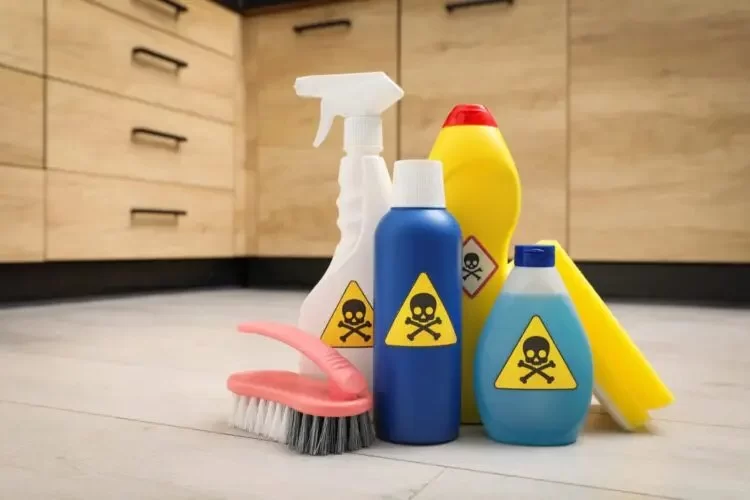- understanding-household-chemical-exposure
- how-daily-products-contribute-to-toxicity
- strategies-for-reducing-chemical-exposure-at-home
- real-stories-from-conscious-households
- long-term-benefits-of-a-low-tox-home
- trusted-platforms-for-healthier-living
1. Understanding Household Chemical Exposure
Most people assume their homes are safe havens—but the truth is, many everyday items release harmful chemicals that affect our health over time. Reducing chemical exposure in your home and environment isn’t just a trendy wellness goal—it’s a crucial step in protecting long-term wellbeing. Chemicals like phthalates, VOCs (volatile organic compounds), and formaldehyde often lurk in common items such as furniture, air fresheners, and cleaning sprays, even in products marketed as “natural.”
Scientific studies have linked prolonged low-level chemical exposure to a wide range of health issues including hormone disruption, asthma, and even certain cancers. The good news? With informed choices and intentional habits, we can dramatically reduce our risk.
2. How Daily Products Contribute to Toxicity
2.1. Cleaning Products
One of the biggest culprits is conventional household cleaners. Many contain synthetic fragrances, ammonia, and bleach—all of which can release fumes that linger and accumulate. Even “green” brands often include undisclosed chemical blends unless they are certified non-toxic.
2.2. Plastics and Food Storage
Plastic containers, especially when microwaved, can leach BPA and other endocrine-disrupting chemicals into your meals. Swapping to stainless steel, glass, or silicone is a small change with long-term impact.
2.3. Personal Care Items
From shampoos to deodorants, personal care routines are filled with unregulated chemical ingredients. The skin absorbs much of what we apply—making ingredient awareness essential. Look for brands that are EWG-verified or certified organic.
3. Strategies for Reducing Chemical Exposure at Home
3.1. Swap One Product at a Time
It can feel overwhelming to overhaul your household at once. A better approach is to replace items as you run out. Start with the most used: laundry detergent, dish soap, and air fresheners. Use fragrance-free or essential-oil-based alternatives instead.
3.2. Improve Air Circulation
Indoor air can be five times more polluted than outdoor air. Use HEPA filters, open windows regularly, and add houseplants like peace lilies or spider plants that naturally purify the air. Avoid synthetic candles and opt for beeswax or soy alternatives.
3.3. Check Certifications and Labels
Look for labels such as USDA Organic, Green Seal, or Made Safe. Apps like Think Dirty and EWG’s Healthy Living can help scan barcodes and evaluate toxicity levels in seconds.
3.4. Go DIY When Possible
Homemade cleaners using baking soda, vinegar, and essential oils are not only safer but also cost-effective. Try a mix of white vinegar, water, and lemon for a natural all-purpose spray.
4. Real Stories from Conscious Households
4.1. Jenna’s Journey to a Low-Tox Nursery
When Jenna from Austin found out she was pregnant, she deep-dived into research on VOCs and toxins in crib mattresses and paint. “I had no idea how many chemicals were hiding in the baby aisle. Now I only buy verified non-toxic items, and it feels empowering to know my daughter’s room is a safe space.”
4.2. Mark’s Asthma Breakthrough
Mark, a 45-year-old dad from Seattle, suffered from chronic asthma. After switching to unscented, natural cleaning supplies and purifying his indoor air, his condition significantly improved. “My breathing is clearer, and I haven’t needed my inhaler in months,” he says.
5. Long-Term Benefits of a Low-Tox Home
5.1. Better Indoor Air Quality
A noticeable difference in how your home smells and feels is just the start. Removing harsh chemicals reduces indoor pollutants, leading to fewer headaches, less fatigue, and improved sleep quality.
5.2. Immune System Support
Reducing chemical exposure takes pressure off the immune system, allowing it to respond more efficiently to real threats—especially critical in households with children or immunocompromised members.
5.3. Environmental Impact
Cleaner choices at home also reduce your overall environmental footprint. Biodegradable cleaners, low-waste packaging, and plant-based ingredients support not just your family’s health but the planet’s too.
6. Trusted Platforms for Healthier Living
If you're looking to make the shift but aren’t sure where to start, explore curated health-conscious products and advice on HeartCare Hub. From non-toxic home essentials to guides on reading labels and choosing wisely, it’s a valuable resource for anyone committed to a cleaner, safer lifestyle.





















